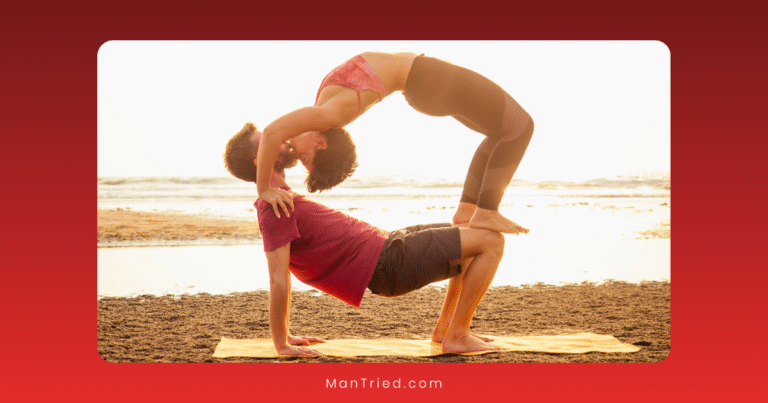From Anxious to Confident: A 30-Day Program for Sexual Self-Assurance

Sexual anxiety affects more people than you might think—studies show that up to 25% of men and 16% of women experience anxiety related to sexual performance. This anxiety can manifest as intrusive thoughts, physical tension, and disconnection during intimate moments, creating a frustrating cycle that undermines pleasure and connection.
The good news? Sexual confidence is a skill that can be developed through consistent practice and intentional focus. This 30-day program combines evidence-based techniques from cognitive behavioral therapy, mindfulness practice, somatic awareness, and communication skills to help you transform anxiety into authentic confidence.
Dr. Emily Nagoski, author of Come As You Are, explains: “Sexual confidence isn’t about perfect performance—it’s about being comfortable in your body, understanding your desires, and communicating effectively with partners.”
This program is designed to be progressive, building from foundational self-awareness in Week 1 to partner communication in Week 4. Each day includes a specific focus and practical exercise requiring just 15-30 minutes. You can adapt the program to your needs, repeating days that feel particularly beneficial or challenging.
Let’s begin the journey from sexual anxiety to genuine confidence.
Week 1: Foundation – Building Self-Awareness and Acceptance
Day 1: Identifying Your Anxiety Triggers
Exercise: Create a “sexual anxiety inventory” by journaling about situations where you feel anxious during intimate encounters. Be specific about physical sensations, thoughts, and emotions that arise. Research from the Journal of Sexual Medicine shows that simply identifying anxiety triggers can reduce their power by up to 30%.
Reflection prompt: “When do I first remember feeling anxious about sexual performance? What messages about sexuality have influenced my expectations?”
Day 2: Body Mapping
Exercise: Spend 15 minutes exploring your body with curiosity rather than judgment. Using a mirror and gentle touch, notice areas of tension, pleasure, and neutrality. Draw an outline of your body and mark these areas with different colors. This exercise, recommended by sex therapists at the Masters and Johnson Institute, helps reconnect with your body as a source of information rather than anxiety.
Reflection prompt: “What parts of my body do I have difficulty accepting? Where do I hold tension during sexual encounters?”
Day 3: Mindful Breathing for Sexual Presence
Exercise: Practice the 4-7-8 breathing technique (inhale for 4 counts, hold for 7, exhale for 8) for 5 minutes. Then do a 10-minute body scan, systematically relaxing each part of your body from toes to head. According to research from the University of California, this practice reduces anxiety by activating the parasympathetic nervous system—essential for sexual arousal.
Reflection prompt: “How does my breathing change when I feel anxious? How does intentional breathing affect my body’s tension?”
Day 4: Pleasure Mapping
Exercise: Set aside 20 minutes for solo exploration focused on identifying what genuinely feels good to you. Without goal-oriented pressure, touch different parts of your body (both genital and non-genital) with varying pressure, speed, and technique. Note what creates pleasure, curiosity, or discomfort. Sex educator Betty Dodson recommends this practice as foundational for developing authentic sexual preferences.
Reflection prompt: “What have I learned about my pleasure that surprises me? How might this knowledge help reduce performance anxiety?”
Day 5: Challenging Negative Sexual Beliefs
Exercise: Identify three negative beliefs you hold about your sexual performance or desirability. For each belief, write evidence that contradicts it and create a more balanced alternative thought. For example, “I always disappoint partners” might become “Different partners have different preferences, and open communication helps create mutual satisfaction.”
Reflection prompt: “Where did these negative beliefs originate? How have they affected my sexual confidence?”
Day 6: Sensory Mindfulness
Exercise: Choose one everyday activity (eating, showering, walking) and experience it with full sensory awareness. Notice textures, temperatures, scents, sounds, and visual details. This practice, recommended by mindfulness expert Jon Kabat-Zinn, strengthens your ability to stay present during sexual experiences rather than getting lost in anxious thoughts.
Reflection prompt: “How does fully engaging my senses affect my experience? What happens when I apply this awareness to intimate moments?”
Day 7: Self-Compassion Practice
Exercise: Write a compassionate letter to yourself about your sexual journey, acknowledging challenges while offering the same kindness you would give a good friend. Research by Dr. Kristin Neff shows that self-compassion reduces anxiety more effectively than self-criticism or forced positivity.
Reflection prompt: “How would my sexual experiences change if I approached them with compassion rather than judgment?”
Week 2: Mindset – Transforming Thoughts and Building Confidence
Day 8: From Performance to Pleasure
Exercise: Create a “pleasure-focused mindset” by listing 10 aspects of sexual experiences you enjoy regardless of “performance” outcomes. This might include sensations, emotional connections, or expressions of desire. Research from the American Association of Sexuality Educators, Counselors and Therapists shows that shifting focus from performance to pleasure significantly reduces anxiety.
Reflection prompt: “How does my experience change when I focus on pleasure rather than performance? What becomes possible?”
Day 9: Confidence Visualization
Exercise: Spend 10 minutes visualizing yourself moving through a sexual encounter with confidence, presence, and enjoyment. Include details about your breathing, posture, communication, and internal experience. Sports psychology research shows that visualization activates many of the same neural pathways as actual practice.
Reflection prompt: “What does sexual confidence look and feel like in my body? What specific behaviors demonstrate this confidence?”
Day 10: Reframing Anxiety as Excitement
Exercise: Practice the “anxiety reappraisal” technique developed by Harvard psychologist Alison Wood Brooks. When you notice sexual anxiety symptoms (racing heart, butterflies), say aloud: “I am excited” rather than “I am anxious.” Studies show this simple reframing improves performance by 15-20% in pressure situations.
Reflection prompt: “How are anxiety and excitement physiologically similar? How does relabeling these sensations change my experience?”
Day 11: Body Confidence Movement
Exercise: Spend 15 minutes moving your body in ways that feel good—dancing, stretching, yoga, or simply swaying. Focus on how movement feels from the inside rather than how it looks. Research from the Body Image Research Group indicates that embodied movement significantly improves body image and sexual confidence.
Reflection prompt: “How does connecting with my body through movement affect my relationship with it? What sensations do I notice?”
Day 12: Creating Sexual Affirmations
Exercise: Develop three personalized affirmations that counter your specific anxieties. For example, “I am present and responsive during intimate moments” or “I communicate my desires with confidence.” Record these in your own voice and listen to them daily. Neurological research shows that personalized affirmations can create new neural pathways when practiced consistently.
Reflection prompt: “What words do I need to hear most about my sexual self? How can I make these affirmations feel authentic?”
Day 13: Pleasure-Focused Masturbation
Exercise: Engage in self-pleasure with a focus on sensation rather than outcome. Remove any pressure to reach orgasm and instead explore what creates enjoyment moment by moment. Sex therapist Dr. Ian Kerner recommends this practice for developing sexual self-awareness and reducing performance pressure.
Reflection prompt: “What happens when I remove goal-orientation from sexual pleasure? How might this translate to partnered experiences?”
Day 14: Celebrating Sexual Growth
Exercise: Review your journal entries from the first two weeks and identify three insights or changes in your relationship with sexuality. Create a small ritual to acknowledge this growth—lighting a candle, writing a poem, or simply taking a moment of gratitude. Positive psychology research shows that celebrating small wins significantly increases motivation for continued growth.
Reflection prompt: “What shifts have I noticed in my sexual confidence so far? What patterns am I beginning to recognize?”
Week 3: Body – Developing Physical Confidence and Presence
Day 15: Pelvic Floor Awareness
Exercise: Learn to identify and consciously relax your pelvic floor muscles through this exercise: Tighten the muscles you would use to stop urination or prevent passing gas, hold for 3 seconds, then release completely for 6 seconds. Repeat 10 times. According to the American Physical Therapy Association, pelvic floor awareness can significantly reduce sexual anxiety and improve sensation.
Reflection prompt: “How does tension in my pelvic floor relate to my sexual anxiety? What happens when I consciously relax these muscles?”
Day 16: Embodied Boundaries Practice
Exercise: Practice saying “yes,” “no,” and “maybe” while paying attention to how each response feels in your body. Stand in a comfortable position and state each word aloud with corresponding body language. This exercise, developed by somatic consent educators, strengthens your ability to recognize and communicate authentic desires and boundaries.
Reflection prompt: “How clearly can I feel my yes, no, and maybe in my body? How might this awareness serve me in sexual contexts?”
Day 17: Sensate Focus Solo Practice
Exercise: Engage in non-goal-oriented touch of your own body for 15 minutes, focusing exclusively on sensations. Begin with non-genital areas and only progress to more sensitive areas if it feels comfortable. This technique, developed by Masters and Johnson, is one of the most evidence-based approaches for overcoming sexual anxiety.
Reflection prompt: “What sensations am I discovering through mindful touch? How does removing performance goals affect my experience?”
Day 18: Breath and Sound Liberation
Exercise: Practice making sounds while breathing deeply for 10 minutes. Start with sighs and gradually explore other sounds that feel authentic. Many people suppress natural sounds during intimacy due to embarrassment, which increases tension and self-consciousness. This exercise, recommended by tantric practitioners, helps release vocal inhibition.
Reflection prompt: “How does making sound affect my breathing and tension levels? What happens when I allow authentic expression?”
Day 19: Confident Posture Practice
Exercise: Spend one day practicing “power postures” for two minutes every few hours—standing or sitting with your spine straight, shoulders back, and body open rather than contracted. Harvard research shows that these postures actually change hormone levels, increasing testosterone and decreasing cortisol (the stress hormone).
Reflection prompt: “How does my physical posture affect my psychological state? What changes do I notice when I adopt more open, confident postures?”
Day 20: Mindful Showering Ritual
Exercise: Transform your daily shower into a self-care ritual by slowly washing each part of your body with appreciation and care. This practice, suggested by somatic therapist Staci Haines, helps counteract body shame and develops a nurturing relationship with your physical self.
Reflection prompt: “How does it feel to touch my body with intentional care? What parts are difficult to appreciate, and why?”
Day 21: Movement and Expression
Exercise: Put on music that makes you feel sensual and move your body freely for 15 minutes without self-judgment. Allow your movement to express different emotions—confidence, desire, playfulness, power. Dance/movement therapists use this approach to integrate emotional and physical expression.
Reflection prompt: “What emotions feel accessible through movement? How might this translate to sexual expression?”
Week 4: Connection – Communicating and Sharing with Partners
Day 22: Desire Mapping
Exercise: Create a “desire map” by writing down your sexual desires in three categories: “Definitely Yes,” “Curious to Explore,” and “Not for Me.” This exercise, recommended by sex educator Emily Nagoski, clarifies your authentic desires and builds confidence in communicating them.
Reflection prompt: “What patterns do I notice in my desires? How might sharing these desires enhance intimacy with partners?”
Day 23: Boundary Script Development
Exercise: Write scripts for communicating boundaries in challenging sexual situations. Include phrases like “I’d prefer to…” or “I need a moment to…” Practice saying these aloud until they feel natural. Research from the National Coalition for Sexual Health shows that pre-planning communication reduces anxiety in the moment.
Reflection prompt: “What makes communicating boundaries difficult for me? How might clear boundaries actually enhance intimacy?”
Day 24: Initiating Intimacy Practice
Exercise: Develop three comfortable ways to initiate intimacy that feel authentic to your personality. These might be verbal, physical, or a combination. Practice these approaches alone through role-play or visualization. Sex therapists at the Gottman Institute emphasize that having multiple initiation strategies reduces pressure and increases success.
Reflection prompt: “What feels authentic when expressing my desire for intimacy? What has held me back from initiating in the past?”
Day 25: Feedback Communication
Exercise: Practice giving positive sexual feedback using the formula: “I love when you _____” or “It feels amazing when you _____.” Record yourself saying these phrases or practice with a trusted friend (discussing non-sexual topics if more comfortable). Positive reinforcement is more effective than criticism for shaping enjoyable experiences.
Reflection prompt: “How comfortable am I expressing enjoyment? How might positive feedback create a more satisfying sexual experience?”
Day 26: Mindful Partner Connection
Exercise: If you have a partner, practice the “eye gazing” exercise—sitting knee-to-knee and making eye contact for 3-5 minutes without speaking. If practicing solo, use a mirror. This exercise, studied by relationship researcher Dr. Arthur Aron, builds comfort with emotional intimacy and presence.
Reflection prompt: “What emotions arise during extended eye contact? How does this practice relate to sexual presence?”
Day 27: Vulnerability Courage
Exercise: Identify one aspect of your sexuality you’ve been hesitant to share with partners. Write a simple, clear way to express this desire, fear, or preference. If in a relationship, consider sharing this with your partner in a non-sexual setting. Researcher Brené Brown’s work shows that appropriate vulnerability increases intimacy and reduces anxiety.
Reflection prompt: “What would become possible in my sexual relationships if I expressed myself more authentically? What’s the worst and best that could happen?”
Day 28: Playfulness Practice
Exercise: Incorporate an element of play into your day—whether through games, lighthearted physical activity, or creative expression. Psychologists at the Kinsey Institute have found that cultivating playfulness significantly reduces sexual anxiety by counteracting perfectionism.
Reflection prompt: “How might bringing a playful attitude into intimate encounters change my experience? What happens when I take sex seriously but not solemnly?”
Day 29: Sensate Focus with Partner
Exercise: If you have a partner, engage in the formal Sensate Focus exercise: 15 minutes of non-goal-oriented touch where one person touches the other with curiosity rather than trying to arouse. Then switch roles. If practicing solo, imagine giving and receiving touch with full presence. This evidence-based technique is a cornerstone of sex therapy for anxiety.
Reflection prompt: “What did I learn about giving and receiving touch without performance pressure? How did this affect my anxiety levels compared to goal-oriented sexual encounters?”
Day 30: Integration and Commitment
Exercise: Create a personalized “sexual confidence maintenance plan” by selecting 3-5 practices from this program that were most beneficial for you. Schedule these into your calendar for the next month. Research from the American Psychological Association shows that specific implementation intentions increase the likelihood of maintaining new habits by 300%.
Reflection prompt: “What have been my most significant insights during this 30-day journey? What specific practices will I continue to support my sexual confidence?”
Beyond the 30 Days: Maintaining and Deepening Sexual Confidence
Congratulations on completing this 30-day journey! Remember that sexual confidence is an ongoing practice rather than a destination. Here are strategies for continuing your growth:
Ongoing Practices for Lasting Confidence
1. Weekly Check-ins
Schedule a weekly 10-minute reflection on your sexual confidence. Notice patterns, challenges, and growth areas. This regular awareness prevents old habits from creeping back unnoticed.
2. Partner Communication Rituals
If in a relationship, establish regular “sexual check-ins” with your partner—perhaps monthly conversations about what’s working well and what you’d like to explore. These conversations are most effective when held outside the bedroom in a relaxed setting.
3. Mindfulness Maintenance
Continue practicing mindfulness for at least 5 minutes daily. Research shows that consistent brief practice is more effective than occasional longer sessions. Apps like Headspace and Calm offer specific meditations for body confidence and anxiety reduction.
4. Body Appreciation Practice
Counter cultural messaging about “perfect” bodies by regularly acknowledging what your body does for you rather than how it looks. Body image researcher Dr. Lindsay Kite suggests a simple daily gratitude practice: “Today I appreciate my body for _____.”
5. Pleasure-Focused Mindset
Continue shifting from performance metrics to pleasure and connection. Ask regularly: “What would make this experience more enjoyable?” rather than “Am I performing well enough?”
When to Seek Additional Support
While this 30-day program can significantly reduce sexual anxiety for many people, some situations benefit from professional support:
Consider working with a sex therapist or counselor if:
- Sexual anxiety persists despite consistent practice
- Past trauma significantly impacts your sexual experiences
- Relationship dynamics complicate sexual confidence
- Medical conditions contribute to sexual concerns
The American Association of Sexuality Educators, Counselors and Therapists provides a directory of certified professionals who specialize in sexual concerns.
The Science Behind This Program
This 30-day program integrates evidence-based approaches from multiple disciplines:
Cognitive Behavioral Therapy (CBT): Many exercises target the thoughts and beliefs that maintain sexual anxiety. Research published in the Journal of Sexual Medicine shows that CBT techniques reduce sexual anxiety by 60-70% for many individuals.
Mindfulness-Based Interventions: The present-moment awareness practices in this program have been studied extensively. A 2019 meta-analysis in the Archives of Sexual Behavior found that mindfulness training significantly improves sexual desire, arousal, and satisfaction while reducing anxiety.
Sensate Focus: Developed by pioneering sex researchers Masters and Johnson, this approach has over 50 years of clinical evidence supporting its effectiveness for sexual concerns. A 2015 study found Sensate Focus therapy to be 83% effective for treating various sexual difficulties.
Somatic Awareness: The body-based exercises draw from somatic psychology, which addresses how emotions and thoughts are experienced physically. Research from the International Journal of Sexual Health indicates that improved body awareness correlates strongly with sexual satisfaction.
Your Sexual Confidence Journey
Sexual confidence is not about performing perfectly or meeting some external standard. It’s about developing a comfortable, authentic relationship with your sexuality—one where anxiety no longer dictates your experiences.
As you complete this 30-day program, remember that the goal isn’t to eliminate all anxiety or uncertainty. Rather, it’s to develop a new relationship with these feelings so they no longer control your sexual experiences. True confidence includes the ability to stay present even when challenges arise.
Dr. Lori Brotto, sex researcher and author of Better Sex Through Mindfulness, notes: “Sexual confidence doesn’t mean never feeling anxious. It means having the tools to navigate anxiety when it arises, staying connected to pleasure and presence despite challenges.”
Your journey toward sexual confidence is uniquely yours. Celebrate your courage in taking these steps, be patient with your progress, and remember that each day of practice builds neural pathways that make confidence more accessible.
We’d love to hear about your experience with this program. What exercises were most helpful? What insights surprised you? Share in the comments below or reach out directly with questions.
Here’s to your journey from anxiety to authentic sexual confidence!
Common Questions About Building Sexual Confidence
Many people report noticeable changes within 2-3 weeks of consistent practice. However, deeper patterns may take longer to shift. The key is consistency rather than perfection.
Simply resume where you left off. This journey isn’t about perfect adherence but about progressive growth. If you miss several days, consider reviewing previous exercises before continuing.
Absolutely! Many exercises focus on your relationship with yourself, which is the foundation of sexual confidence whether you’re currently partnered or not. In fact, solo practice can be ideal for developing confidence without the added complexity of partner dynamics.
Approach the conversation with an emphasis on enhancing pleasure and connection rather than “fixing” something. You might say, “I’ve found this program that helps build sexual confidence and deepen intimacy. Would you be open to exploring some of the partner exercises with me?” Remember that your partner’s participation is optional—many exercises can be adapted for solo practice.
Some discomfort is normal when exploring new territory, but distress is not the goal. If an exercise triggers significant distress, consider:
- Modifying it to make it more accessible
- Journaling about your reaction to understand it better
- Returning to it later after building more foundation
- Consulting with a therapist for additional support






